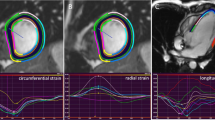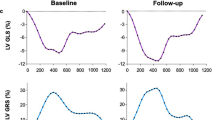Abstract
Objectives
This study assessed the applicability and prognostic value of cardiovascular magnetic resonance (CMR) left ventricular deformation analysis in Takotsubo syndrome (TTS).
Methods
CMR-feature tracking was performed blinded in a core laboratory to determine circumferential (CS), radial (RS) and longitudinal strain (LS) in 141 TTS patients participating in this cohort study. A subgroup of consecutive TTS patients (n = 20) was compared with age- and sex-matched controls with anterior ST-segment elevation myocardial infarction (STEMI) and non-STEMI as well as healthy subjects.
Results
Median global CS, RS and LS were -19%, 19% and -12%, respectively. Apical ballooning was associated with significantly lower global CS (p < 0.01) and LS (p < 0.01) compared with midventricular and basal ballooning. Global RS was lowest in patients with basal ballooning (p < 0.01). Segmental analysis resulted in a reliable discrimination of different ballooning patterns using CS and LS. Strain values were significantly lower in TTS compared with non-STEMI patients and healthy subjects, whereas STEMI patients showed similar values. While global CS and RS were not associated with long-term mortality, global LS (cutoff -14.75%) was identified as a potential parameter for long-term risk stratification (mortality rate 17.9% versus 2.5%; p = 0.02).
Conclusions
The transient contraction abnormalities in TTS can be quantitatively assessed with CMR-feature tracking. GLS is a potential determinant of outcome in TTS, which, however, requires further validation.
Key Points
• Cardiovascular magnetic resonance myocardial feature tracking enables accurate assessment of regional and global left ventricular dysfunction in Takotsubo syndrome (TTS).
• Global strain in TTS is similar to patients with anterior STEMI and lower compared with non-STEMI and healthy subjects.
• Global longitudinal strain is a potential tool for risk prediction in TTS patients.





Similar content being viewed by others
Abbreviations
- CMR:
-
Cardiovascular magnetic resonance
- CMR-FT:
-
Cardiovascular magnetic resonance myocardial feature tracking
- CS:
-
Circumferential strain
- GCS:
-
Global circumferential strain
- GLS:
-
Global longitudinal strain
- GRS:
-
Global radial strain
- IQR:
-
Interquartile range
- LS:
-
Longitudinal strain
- LV:
-
Left ventricular
- NSTEMI:
-
Non-ST-segment elevation myocardial infarction
- RS:
-
Radial strain
- SSFP:
-
Steady state-free precession
- STEMI:
-
ST-segment elevation myocardial infarction
- TTP:
-
Time to peak
- TTE:
-
Transthoracic echocardiography
- TTS:
-
Takotsubo syndrome
References
Lyon AR, Bossone E, Schneider B et al (2016) Current state of knowledge on Takotsubo syndrome: a position statement from the Taskforce on Takotsubo Syndrome of the Heart Failure Association of the European Society of Cardiology. Eur J Heart Fail 18:8–27
Eitel I, von Knobelsdorff-Brenkenhoff F, Bernhardt P et al (2011) Clinical characteristics and cardiovascular magnetic resonance findings in stress (takotsubo) cardiomyopathy. JAMA 306:277–286
Prasad A, Lerman A, Rihal CS (2008) Apical ballooning syndrome (Tako-Tsubo or stress cardiomyopathy): a mimic of acute myocardial infarction. Am Heart J 155:408–417
Schuster A, Hor KN, Kowallick JT, Beerbaum P, Kutty S (2016) Cardiovascular magnetic resonance myocardial feature tracking: concepts and clinical applications. Circ Cardiovasc Imaging 9:e004077
Schuster A, Paul M, Bettencourt N et al (2015) Myocardial feature tracking reduces observer-dependence in low-dose dobutamine stress cardiovascular magnetic resonance. PLoS One 10:e0122858
Stiermaier T, Moeller C, Oehler K et al (2016) Long-term excess mortality in takotsubo cardiomyopathy: predictors, causes and clinical consequences. Eur J Heart Fail 18:650–656
Templin C, Ghadri JR, Diekmann J et al (2015) Clinical features and outcomes of Takotsubo (stress) cardiomyopathy. N Engl J Med 373:929–938
Stiermaier T, Eitel C, Denef S et al (2015) Prevalence and clinical significance of life-threatening arrhythmias in Takotsubo cardiomyopathy. J Am Coll Cardiol 65:2148–2150
Ghadri JR, Cammann VL, Napp LC et al (2016) Differences in the clinical profile and outcomes of typical and atypical Takotsubo syndrome: data from the International Takotsubo Registry. JAMA Cardiol 1:335–340
Stiermaier T, Moller C, Graf T et al (2016) Prognostic usefulness of the ballooning pattern in patients with Takotsubo cardiomyopathy. Am J Cardiol 118:1737–1741
Buss SJ, Breuninger K, Lehrke S et al (2015) Assessment of myocardial deformation with cardiac magnetic resonance strain imaging improves risk stratification in patients with dilated cardiomyopathy. Eur Heart J Cardiovasc Imaging 16:307–315
Eitel I, Wohrle J, Suenkel H et al (2013) Intracoronary compared with intravenous bolus abciximab application during primary percutaneous coronary intervention in ST-segment elevation myocardial infarction: cardiac magnetic resonance substudy of the AIDA STEMI trial. J Am Coll Cardiol 61:1447–1454
Thiele H, de Waha S, Zeymer U et al (2014) Effect of aspiration thrombectomy on microvascular obstruction in NSTEMI patients: the TATORT-NSTEMI trial. J Am Coll Cardiol 64:1117–1124
Friedrich MG, Sechtem U, Schulz-Menger J et al (2009) Cardiovascular magnetic resonance in myocarditis: a JACC White Paper. J Am Coll Cardiol 53:1475–1487
Eitel I, Behrendt F, Schindler K et al (2008) Differential diagnosis of suspected apical ballooning syndrome using contrast-enhanced magnetic resonance imaging. Eur Heart J 29:2651–2659
Hor KN, Gottliebson WM, Carson C et al (2010) Comparison of magnetic resonance feature tracking for strain calculation with harmonic phase imaging analysis. JACC Cardiovasc Imaging 3:144–151
Kempny A, Fernandez-Jimenez R, Orwat S et al (2012) Quantification of biventricular myocardial function using cardiac magnetic resonance feature tracking, endocardial border delineation and echocardiographic speckle tracking in patients with repaired tetralogy of Fallot and healthy controls. J Cardiovasc Magn Reson 14:32
Schuster A, Stahnke VC, Unterberg-Buchwald C et al (2015) Cardiovascular magnetic resonance feature-tracking assessment of myocardial mechanics: Intervendor agreement and considerations regarding reproducibility. Clin Radiol 70:989–998
Schuster A, Kutty S, Padiyath A et al (2011) Cardiovascular magnetic resonance myocardial feature tracking detects quantitative wall motion during dobutamine stress. J Cardiovasc Magn Reson 13:58
Kowallick JT, Morton G, Lamata P et al (2016) Inter-study reproducibility of left ventricular torsion and torsion rate quantification using MR myocardial feature tracking. J Magn Reson Imaging 43:128–137
Citro R, Lyon AR, Meimoun P et al (2015) Standard and advanced echocardiography in takotsubo (stress) cardiomyopathy: clinical and prognostic implications. J Am Soc Echocardiogr 28:57–74
Heggemann F, Hamm K, Kaelsch T et al (2011) Global and regional myocardial function quantification in Takotsubo cardiomyopathy in comparison to acute anterior myocardial infarction using two-dimensional (2D) strain echocardiography. Echocardiography 28:715–719
Burri MV, Nanda NC, Lloyd SG et al (2008) Assessment of systolic and diastolic left ventricular and left atrial function using vector velocity imaging in Takotsubo cardiomyopathy. Echocardiography 25:1138–1144
Heggemann F, Weiss C, Hamm K et al (2009) Global and regional myocardial function quantification by two-dimensional strain in Takotsubo cardiomyopathy. Eur J Echocardiogr 10:760–764
Andre F, Steen H, Matheis P et al (2015) Age- and gender-related normal left ventricular deformation assessed by cardiovascular magnetic resonance feature tracking. J Cardiovasc Magn Reson 17:25
Taylor RJ, Moody WE, Umar F et al (2015) Myocardial strain measurement with feature-tracking cardiovascular magnetic resonance: normal values. Eur Heart J Cardiovasc Imaging 16:871–881
Eitel I, Desch S, Sareban M et al (2009) Prognostic significance and magnetic resonance imaging findings in aborted myocardial infarction after primary angioplasty. Am Heart J 158:806–813
Shetye A, Nazir SA, Squire IB, McCann GP (2015) Global myocardial strain assessment by different imaging modalities to predict outcomes after ST-elevation myocardial infarction: a systematic review. World J Cardiol 7:948–960
Orwat S, Diller GP, Kempny A et al (2016) Myocardial deformation parameters predict outcome in patients with repaired tetralogy of Fallot. Heart 102:209–215
Morton G, Schuster A, Jogiya R, Kutty S, Beerbaum P, Nagel E (2012) Inter-study reproducibility of cardiovascular magnetic resonance myocardial feature tracking. J Cardiovasc Magn Reson 14:43
Obokata M, Nagata Y, Wu VC et al (2016) Direct comparison of cardiac magnetic resonance feature tracking and 2D/3D echocardiography speckle tracking for evaluation of global left ventricular strain. Eur Heart J Cardiovasc Imaging 17:525–532
Acknowledgments
The authors are grateful for the financial support provided by the German Center for Cardiovascular Research (DZHK).
Funding
This study has received funding by the German Center for Cardiovascular Research (DZHK).
Author information
Authors and Affiliations
Corresponding author
Ethics declarations
Guarantor
The scientific guarantors of this publication are Ingo Eitel and Andreas Schuster.
Conflict of interest
The authors of this manuscript declare no relationships with any companies, whose products or services may be related to the subject matter of the article.
Statistics and biometry
One of the authors has significant statistical expertise.
Informed consent
Written informed consent was obtained from all subjects (patients) in this study.
Ethical approval
Institutional Review Board approval was obtained.
Methodology
• Retrospective analysis of prospectively collected data
• Observational diagnostic and prognostic study
• Multicenter study
Additional information
Thomas Stiermaier and Torben Lange should be considered as first authors.
Andreas Schuster and Ingo Eitel should be considered as senior authors.
Electronic supplementary material
Rights and permissions
About this article
Cite this article
Stiermaier, T., Lange, T., Chiribiri, A. et al. Left ventricular myocardial deformation in Takotsubo syndrome: a cardiovascular magnetic resonance myocardial feature tracking study. Eur Radiol 28, 5160–5170 (2018). https://doi.org/10.1007/s00330-018-5475-2
Received:
Revised:
Accepted:
Published:
Issue Date:
DOI: https://doi.org/10.1007/s00330-018-5475-2




